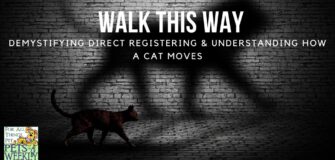The Ultimate Guide to Keeping Dogs Contained in Your Yard
Share
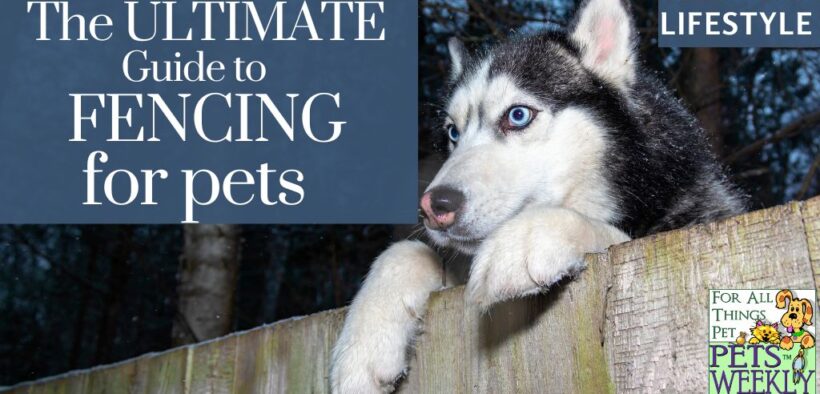
Keeping your dog safe, secure and contained in your yard is a top priority for pet owners. Whether you have a large backyard or a small garden, there are many options available to ensure your best friend stays within the confines of your property.
In this comprehensive guide, we’ll explore different methods for keeping dogs contained, including popular solutions like Coyote Rollers, Double Gates, Invisible Fencing, Installing Footers, and Kennels or dog runs.
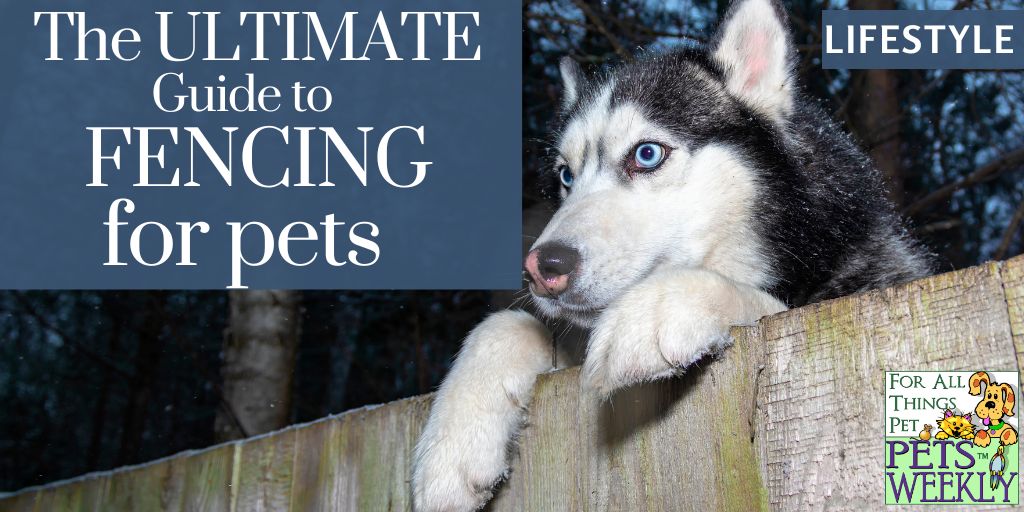
Traditional Fencing: Tried and True Fencing that Can be Easily Modified
Fencing is one of the most traditional and effective ways to keep your dog safely contained within your yard. The type of fencing you choose will depend on various factors such as the size and breed of your dog, your budget, and the aesthetics you prefer for your property. Wooden and metal fences are popular choices due to their durability and versatility. Here are some considerations for each type of fencing.
a. Wooden or Metal Fencing:
- Consider installing a sturdy wooden or metal fence around your yard.
- Choose a durable wood species such as cedar or redwood for longevity.
- Ensure the fence is tall enough to prevent jumping or climbing.
- Opt for a height that corresponds to your dog’s size; larger breeds may require taller fences.
- Regularly treat the wood with a weather-resistant sealant to prevent rot and decay.
- Ensure snow does not pile up around the base of the fence that would enable dogs to jump.
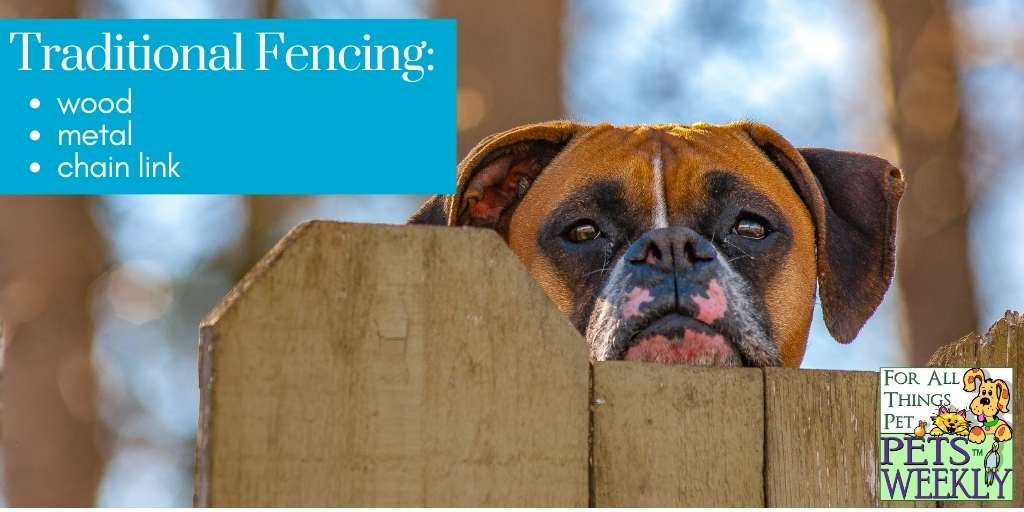
b. Chain Link Fencing:
Chain link fencing is a practical and cost-effective solution for dog containment. Not only are most kennels and dog runs (as well as a few cat enclosures – like ours) made from chain link fencing, it’s affordable, easily accessible and durable. Here are some considerations for installing chain link fencing for dogs.
- Chain link fences are durable and provide visibility.
- Opt for a higher gauge to enhance strength and durability.
- Chain link or wrought iron fences are excellent for visibility and durability.
- Ensure the gaps between the links or bars are small enough to prevent smaller dogs from squeezing through.
- Powder-coated metal resists rust and adds an extra layer of protection against the elements.
- If your dog is fence aggressive, consider adding a shade cloth or privacy screen as a barrier between the street and your yard.
- Choose a higher gauge for increased strength and longevity.
- Opt for a mesh size that prevents your dog from getting paws or snouts caught between the links.
- Install a top rail or tension wire (coyote rollers are also super effective) for added stability and to discourage climbing.
- Tension wires along the bottom helps prevent digging and escape attempts.
2. Coyote Rollers: Preventing Escapes with Ingenious Technology
a. What are Coyote Rollers?
Coyote Rollers are an innovative and humane solution designed to keep dogs from scaling fences. Originally developed to deter coyotes, these devices have proven effective for preventing various animals, including dogs, from climbing over barriers.
The best part of coyote rollers is how adaptable they are. They can be used on virtually any type of fence to keep dogs in the yard and predators out of the yard. They can be added to chain link, wood, kennels, and more. But, best of all, they are very affordable and super effective!
Coyote Rollers consist of cylindrical bars (generally PVC pipe) that are mounted along the top of a fence. The concept is simple yet ingenious: when a dog attempts to climb the fence, the rollers spin freely, preventing the dog from gaining a foothold or grip. This makes it difficult for them to successfully scale the barrier.
- Coyote Rollers are devices installed on top of fences to prevent dogs from scaling them.
- The rollers spin freely, making it difficult for dogs to gain traction.
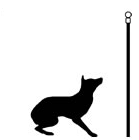
b. Benefits of Coyote Rollers
Coyote Rollers provide a humane alternative to electric fences or sharp spikes. They deter climbing without causing harm to the animal. Once installed, Coyote Rollers require minimal maintenance. They are extremely versatile and are suitable for a variety of fence types, including wooden, chain link, or wrought iron. Best of all, they are affordable and can be installed on existing fences or incorporated into new fence designs.
c. Installing Coyote Rollers:
Proper installation is essential for the effectiveness of Coyote Rollers. We have written a step-by-step guide on installing coyote rollers. But, this is the short version:
- Measure and Align:
- Measure the length of your fence and purchase rollers accordingly.
- Ensure proper alignment along the top of the fence, leaving no gaps.
- Adjust the spacing of the rollers based on the size and agility of your dog.
- Smaller dogs may require closer spacing to prevent squeezing through.
- Mount:
- Securely mount the rollers to the top of the fence using brackets or mounts.
- Follow the manufacturer’s guidelines for spacing to optimize the system.
- Test and Adjust:
- After installation, test the rollers to ensure they spin freely.
- Adjust the tension to find the right balance between ease of spinning and resistance.
- Ensure compatibility with other security measures, such as gates and locks.
- Coyote Rollers can complement traditional fencing for comprehensive containment.
While some pet owners opt for DIY installation, professional installation may be preferred for precise alignment and optimal performance. Professionals can also offer guidance on the best configuration based on your specific needs.
Coyote Rollers are an effective and visually unobtrusive solution for preventing dogs from escaping over fences. By incorporating this technology into your containment strategy, you enhance the security of your yard while allowing your dog to enjoy the outdoors safely.
3. Double Gates: Enhancing Security & Convenience
Double gates, also known as airlock or vestibule gates, serve as a strategic addition to traditional single-gate entry systems. The primary purpose is to enhance security by minimizing the risk of accidental escapes when entering or exiting the yard. They add an extra layer of security by creating an “airlock system” of types. But most of all, they prevent accidental escapes when opening a gate.
a. Benefits of Double Gates:
- Accidental Escape Prevention:
- The airlock system created by double gates reduces the likelihood of a dog slipping through an open gate.
- When one gate is open, the other remains closed, creating a secure transition space.
- Enhanced Security:
- Double gates add an extra layer of security, deterring unauthorized access or intruders.
- Provides a controlled entry and exit point for both humans and pets.
- Convenience for Pet Owners:
- Pet owners can enter or exit the yard without the risk of their dog bolting through the open gate.
- Particularly useful in busy households or when managing multiple pets.
b. Installation Tips for Double Gate Systems:
DIY installation can be cost-effective if you have the necessary skills and tools. Purchase gate kits that include all the required components and follow the manufacturer’s instructions. The cost of installing double gates can vary based on factors such as materials, size, and whether you choose to install them yourself or hire professionals.
Hiring professionals ensures precise alignment and adherence to safety standards. They do, however, tend to be sturdier and last longer. Costs may include labor, materials, and any additional features like automated openers.
These are some additional considerations, as you want to ensure that both gates are self-closing and self-latching:
- Self-Closing Mechanism:
- Install self-closing hinges on both gates to ensure they automatically close behind you.
- This feature is crucial for maintaining the airlock system and preventing accidental escapes.
- Self-Latching Mechanism:
- Use self-latching mechanisms on both gates to further enhance security.
- Ensure that the latch is positioned at a height that is not easily reachable by your dog.
- Gate Material and Design:
- Choose sturdy materials for the gates, such as metal or wood, to ensure durability.
- The design should complement the overall aesthetics of your fencing.
c. Maintenance of Double Gate Systems
Regular maintenance is crucial to ensure the continued effectiveness of double gates, but fortunately, it doesn’t take much to keep up with the maintenance:
- Check hinges and latches regularly for wear and tear.
- Lubricate moving parts to prevent stiffness or rust.
- Inspect the gate structure for any signs of damage.
Double gates provide a practical solution for preventing accidental escapes and enhancing overall security. The investment in this additional feature can significantly contribute to the safety and peace of mind of both pet owners and their furry companions.
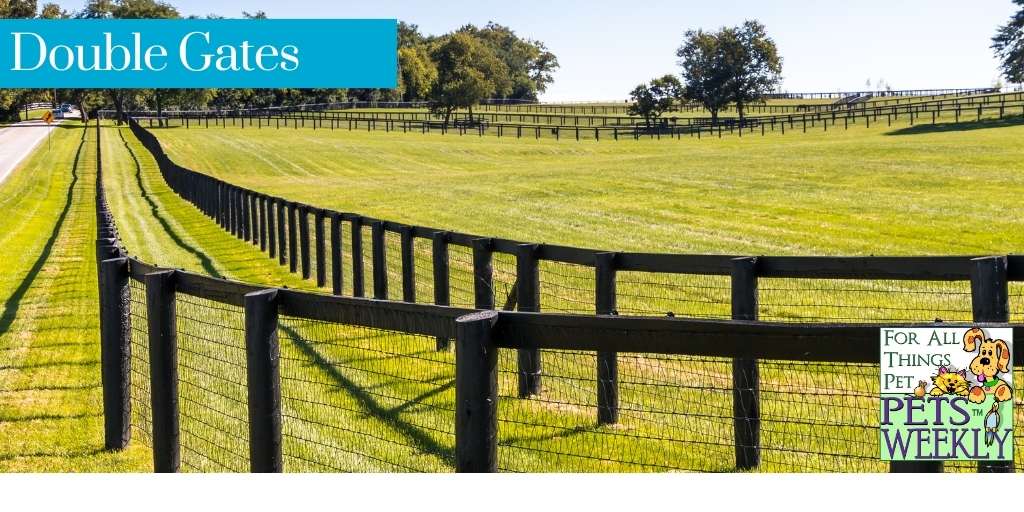
4. Invisible Fencing
Invisible fencing, also known as underground or electric fencing, operates through a buried wire that creates a virtual boundary around your yard. Dogs wear a collar with a receiver that emits a warning tone or mild correction that can increase the closer they approach the boundary. This, in effect, creates a virtual boundary.
It’s imperative that you properly train your dog to understand the boundaries. You also need to regularly check the system for malfunctions and replace batteries as needed.
a. The Training and Introduction of Invisible Fence:
- Positive Reinforcement:
- Train your dog to associate the warning tone with the boundary by using positive reinforcement, such as treats.
- Gradually introduce the correction level to discourage crossing the boundary.
- Consistent Training:
- Consistency is key to successful training. Regularly reinforce the boundaries with short training sessions.
- Be patient and attentive to your dog’s reactions, adjusting the training pace accordingly.
c. The Pros of Invisible Fencing:
The only time I could see using Invisible Fencing is when you are in a highly restrictive HOA association that does not allow fencing. Even then, I would urge you to choose long walks and enrichment over an invisible fence. But, I also understand it is often the only option available for some people. That said, let’s discuss the pros and cons of using these systems.
- Unobtrusive Design:
- Unlike traditional fences, invisible fencing doesn’t alter the visual aesthetics of your yard.
- Ideal for homeowners who want to maintain an open and unencumbered landscape.
- Customizable Boundaries:
- You have the flexibility to customize the boundaries based on your yard’s layout.
- Easily protect specific areas while allowing your dog access to others.
- Cost-Effective:
- Invisible fencing is often more cost-effective than installing traditional fencing.
- It can be a practical solution for those on a budget or in areas with restrictive HOA regulations.
d. The Cons of Invisible Fencing:
One serious issue I have with this type of fencing is the inability to protect your dogs. For example, any wildlife can waltz into your yard and attack your pets. Any human could do the same. Your dog would be unable to escape. There are other cons as well:
- Learning Curve for Dogs:
- Some dogs may require more time to understand the invisible boundaries.
- Highly determined or stubborn dogs may challenge the system.
- No Protection from External Threats:
- Invisible fencing primarily prevents dogs from leaving the yard, but it doesn’t offer protection from external threats like wildlife or intruders.
- Consider combining invisible fencing with other security measures.
- Potential for Collar Aversion:
- Some dogs may develop aversions to wearing the collar, which could impact the effectiveness of the system.
- They may only behave when the collar is on, which is a problem should they gain access to the outdoors unexpectedly.
- The collars can be very frightening for sensitive dogs and may cause fear-based aggression or other behavioral issues.
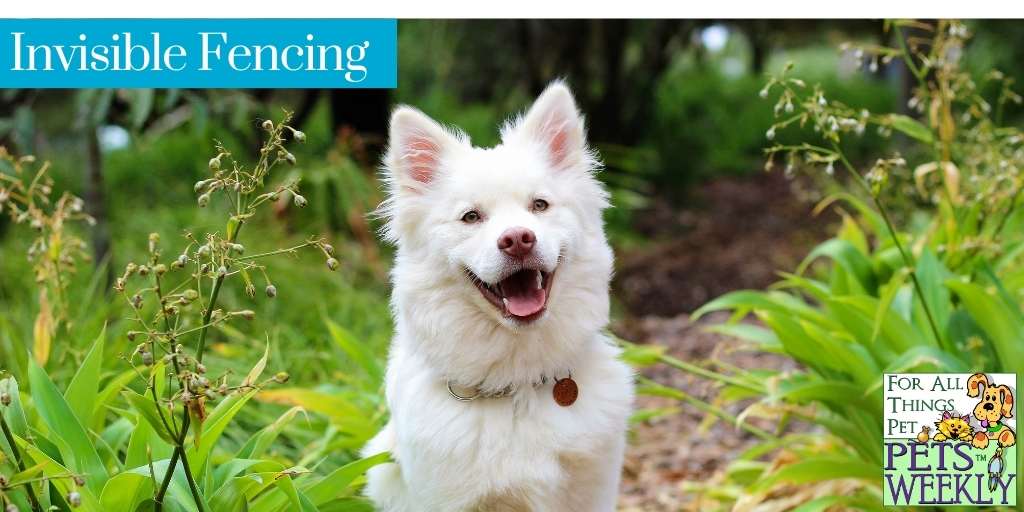
5. Installing Footers
If you have a devoted digger in your dog family, you know how tough it can be to deter them from doing it. We always prefer behavioral training over other methods. Obviously, it’s best to start training young. Show them that digging is okay in specific areas and at certain times. This is a great little enrichment toy for hardcore diggers.
No matter what type of fence you install, you need to consider footings. These are concrete forms that extend along the base of the fence and keep dogs from digging out and predators from digging in. It’s one more tool in your arsenal!
a. Purpose of Footers:
- Digging is a common escape tactic for dogs.
- Installing footers underground can deter digging and prevent escapes.
b. Installing Footers:
- Dig a trench along the perimeter of the fence.
- Insert chicken wire or hardware cloth and cover with soil.
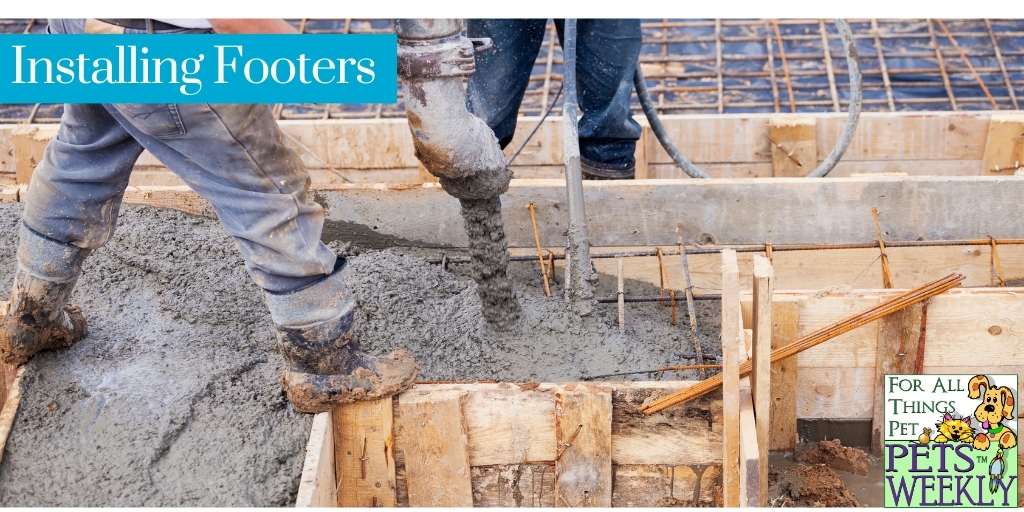
6. Kennels or Dog Runs
a. Benefits of Kennels:
- Kennels provide a secure, enclosed space for dogs.
- Ideal for temporary containment or when you’re away from home.
b. Designing a Dog Run:
- Choose a size appropriate for your dog’s breed and activity level.
- Ensure proper ventilation and shade within the kennel.
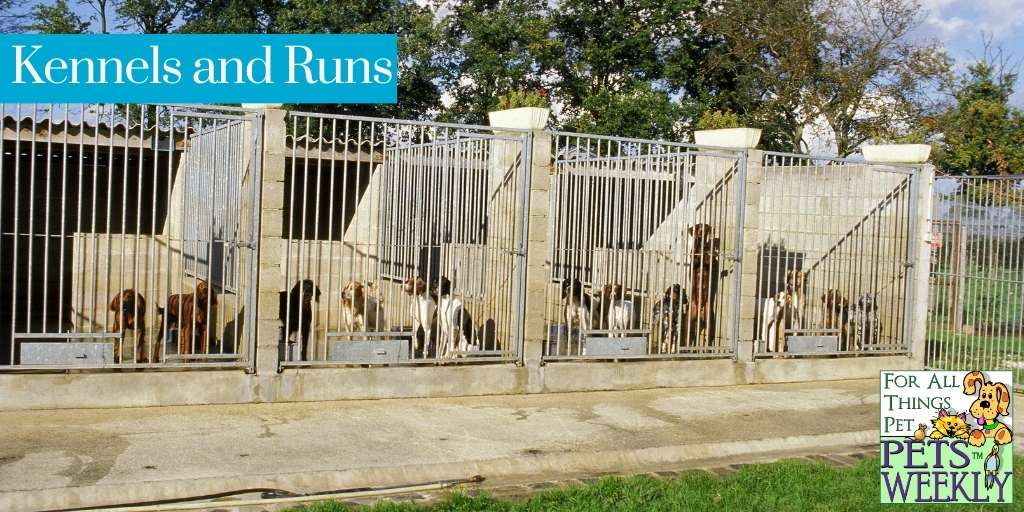
DIY vs Professional Installation
Deciding whether to install the fence yourself or hire professionals depends on your skills, time, and the complexity of the project. DIY installations can be cost-effective, but professional installers ensure a secure and properly aligned fence.
Maintenance
Regardless of the type of fence you choose, regular maintenance is crucial for longevity and effectiveness:
- Inspect the fence regularly for any loose boards, rust, or damage.
- Trim vegetation around the fence to prevent dogs from using it as a launching pad for escapes.
- Repaint or reseal wooden fences as needed to protect against the elements.
Keeping your dog contained in your yard requires a combination of thoughtful planning and the right tools. Always consider the size, breed, and behavior of your dog when choosing the most suitable containment method. If your dog is a digger, you need to consider adding footings or safe in-ground digging deterrents.
Remember, the key to successful containment is a well-maintained and properly installed fence that suits your dog’s needs and behavior. A solid fence not only enhances the safety of your pet but also provides a sense of security and freedom for both you and your furry companion.
Whether it’s traditional fencing, innovative solutions like Coyote Rollers, or the convenience of invisible fencing, finding the right approach will provide peace of mind and ensure your furry friend stays safe and happy in your yard.










